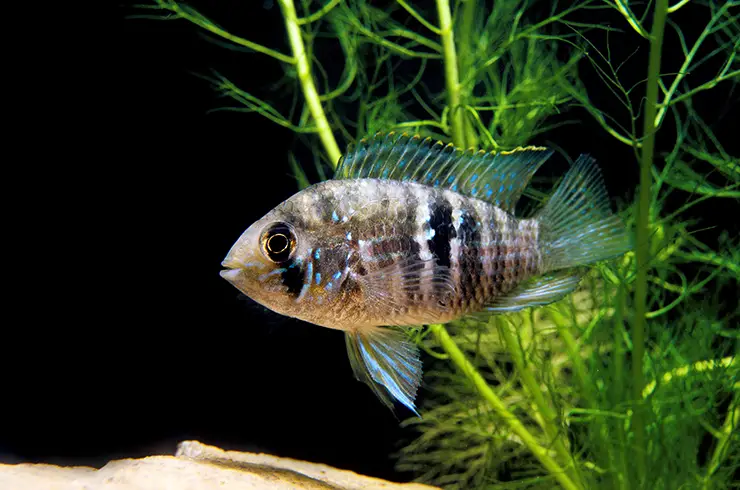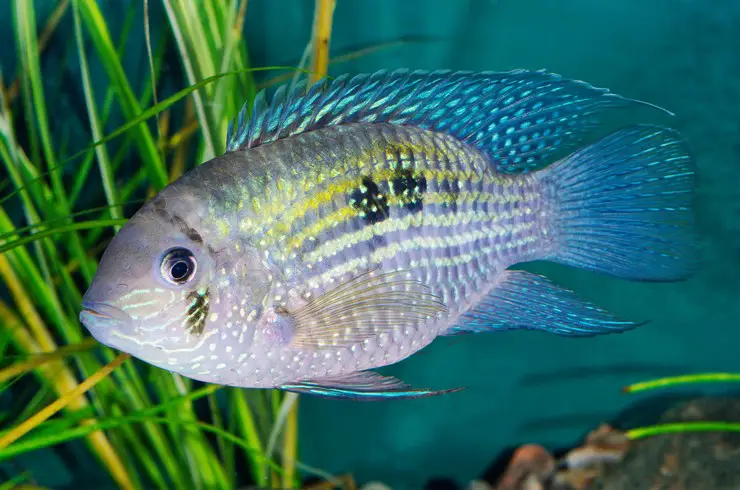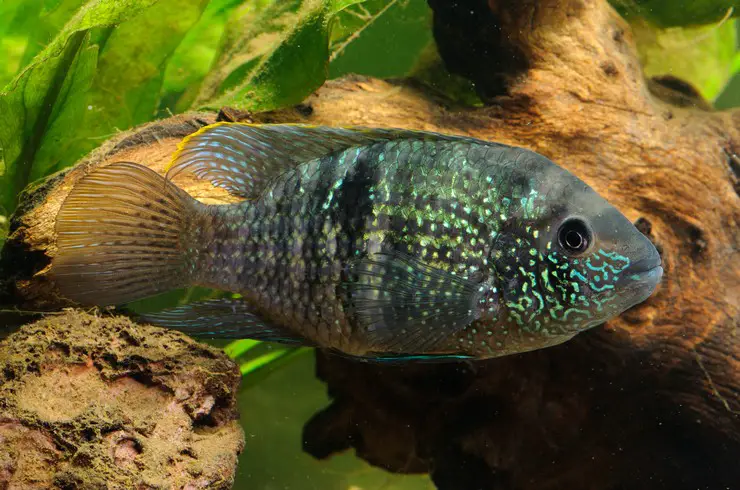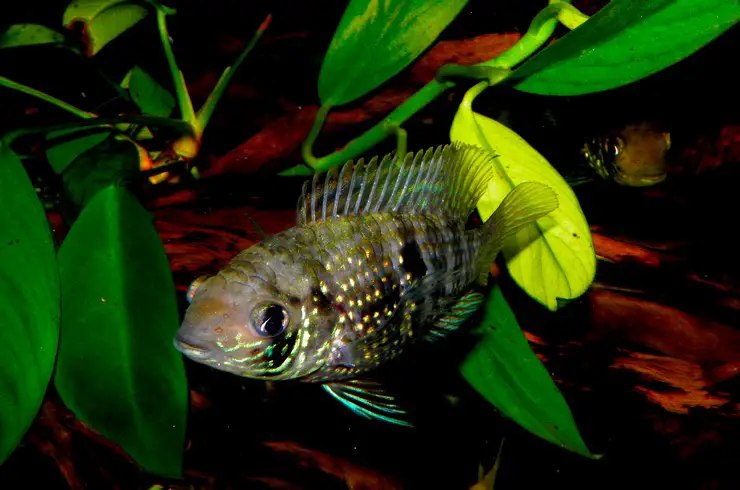Speaking about large cichlids of Central and South America, one cannot fail to mention one of the most beautiful aquarium fish – the bluish-spotted Acar. It is a little less famous than its relative, the turquoise akara, but nevertheless, it is incredibly popular among lovers of large and smart fish. From our article, you will learn how to properly contain blue cancers and whether they are as aggressive as their more eminent relatives.
General information
Acara bluish-spotted or blue (Andinoacara pulcher) is a freshwater ray-finned fish from the Tsikhlov family. Lives in South America received the first scientific description in the second half of the 19th century.
Blue akara is a medium-sized fish with a fairly calm disposition. But we must not forget that this is a real carnivorous cichlid, which is characterized by pronounced territoriality, especially acute during the spawning period.
This is an unusually beautiful fish, which is why it got its Latin epithet “pulcher”, which translates as “beautiful”.
Blue akara will be an excellent choice for novice cikhlovod breeders, because the fish is not only cute, but also hardy, and also perfectly adapts to various water parameters.
And they are also good parents who protect their clutch, and then the fry that has appeared until they get stronger.
Appearance
The blue akara has a tall and dense body. The fish can grow up to a maximum of 15 cm, while its closest relative, the turquoise acara, grows twice as large.
The muzzle of the blue acara is pointed, with large eyes and a mouth with fleshy lips on it. Fatty growth on the head of the male practically does not develop.
The tail is single-lobed. The dorsal fin extends almost from the very head and tapers towards the back of the body, especially in males. The anal and pelvic fins are well developed, decorated with a pattern of bluish strokes. The pectoral fins are practically transparent. A red-yellow edging runs along the edge of the dorsal fin.
As the name implies, the main body color of the fish is bluish or light gray. The area just behind the gills and a little further is covered with a network of spots that reflect light.
Life expectancy is up to 10 years.
Habitat
Blue acara in its natural habitat is found in Central (Panama, Trinidad Island) and South America (Venezuela, Colombia). At the same time, the fish inhabits a variety of biotopes. It can be found both inflowing reservoirs with clear water and in stagnant muddy water.
Care and maintenance
The most suitable aquarium for keeping bluish-spotted crayfish starts at 100 liters. A couple of fish can be placed in such a container quite comfortably. It is best to plant a male and a female. If the volume of the aquarium allows, the content of the group is allowed. But in this case, it is important that the females prevail and many hiding places are organized. The aquarium should be equipped with a lid to prevent cancer from jumping out.
The soil is usually used soft – sand or small pebbles. It is recommended to install branched driftwood and natural stones inside, forming natural shelters. Blue akars are very fond of digging the ground, so you should refuse to plant root plants. Or put them in separate pots and surround them with stones to prevent fish from accessing them. But floating plants (hornwort, riccia, pistia) will come in handy more than ever: they will create a natural darkening, which cancer is very fond of.
For maximum fish comfort, equip your aquarium with a powerful external filter and compressor. Once a week, it is necessary to replace 20% of the water with fresh water. Make sure to add 5 ml of Tetra AquaSafe Conditioner for every 10 liters of water. The tool will instantly make the water safe for the life of fish, as well as enrich it with useful vitamins and microelements. After such treatment, tap water can be safely poured into the aquarium without fear for the health of your pets, you will no longer have to defend it.
Optimum water parameters for the content: T = 22-28 ° C, pH = 6.5-7.5, GH = 6-16.
Compatibility
Bluish-spotted akara, unlike its cousin the green acara, is much more balanced and more suitable for keeping in general aquariums. This is a rather peaceful fish, the peak of aggression of which occurs only during the breeding season.
In fish neighbors, it is best to choose species that are similar in size and temperament. For example, black-striped cichlazomas, scalars, cichlazomas of Meek, nannakara, etc. are perfect. Fish get along well with catfish – corridors, ancistrus, torakatums, platidoras. It is better not to combine cancer with shrimps and snails.
Feeding akara blue
Proteins should be present in sufficient quantities in the diet of bluefish because in nature this fish is a predator that feeds on worms, mollusks, invertebrate larvae. Live and frozen food, despite its popularity, have a number of disadvantages – they are not balanced, they are inconvenient to store, but the worst thing is that they can become a source of infection in the aquarium. To avoid such troubles, while providing the fish with a complete and healthy diet, it is best to opt for quality dry food for cichlids, for example, the Tetra Cichlid line.
You can choose the form of food that is convenient for you or your fish like flakes (Tetra Cichlid XL Flakes), chips (Tetra Cichlid Crisps), granules (Tetra Cichlid Granules), or sticks (Tetra Cichlid Sticks). But whichever feed you focus on, you can be sure that your pets will receive the highest quality foods that will ensure their healthy growth and longevity.
It is best to feed blue cancer 2 times a day in small portions.
Reproduction and breeding
Bluish-spotted crayfish are easily bred at home. A well-developed parental instinct contributes to this.
Gender differences in fish are weak. You can pay attention to the dorsal and anal fins – in males, they are usually more elongated and pointed.
Puberty occurs in fish at the age of 9-11 months, at which time they are about 10 cm in size.
To be sure to guess with the producers, it is best to leave the choice to the fish themselves. To do this, 6 young individuals are usually bought and observed until pairs are formed. It is better to remove the rest of the fish (if the aquarium is small).
It is desirable that flat stones or broadleaf plants be installed in the aquarium with blue crayfish – these will serve as potential spawning grounds.
